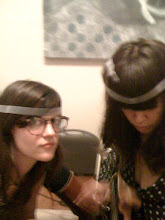
I had no idea what to expect for the performance billed 'Joan Jonas reading Dante.' I read the Performa summary, which lent almost no information, as well an ArtForum article about the work as instantiated for the 2008 Biennale of Sydney and some other scraps; yet nowhere in the limited information that I could cobble together even remotely conveyed a true sense of the piece. So far, I haven't even found extensive video documentation. It's a shame, because I had my camera, and was sitting dead front center, but with Barbara London three seats to my immediate right, but I didn't want to do anything "uncouth."
Pure, experimentation unfurling through several delicate televisual layers, as well as live performance, the work was comprised of previously shot footage (in Canada recently, and New York in the 1970s with Pat Steir) displayed in the background as a floor- to-ceiling video screen. There were also at least two closed circuit video cameras recording intermittently throughout the performance, and manipulated live as well. The visible camera was part of Joan's drawing and video "laboratory," a vanity sized table to the right of the stage where footage of her live action drawing was taken; floating in and out of the video screen behind. The other, less obvious closed circuit video camera taped either Joan or her assistant, Ragani Haas, as they performed on stage. The second closed-circuit camera used a blue trail effect, and typically was overlaid on top of other footage, producing at once an ethereal and organic vibe.



Joan and/or Ragani interacted with the the video a couple of different ways; all of which were quite captivating. One or both of them would respond to the image behind them on screen, Joan would draw at her laboratory on camera, or would draw on the stage space. These drawings, enacted with white chalk tied to long sticks laid the process of the work bare before the audience; and visually revealed the thought behind the work.
The performance was comprised of about 10 movements. In one, there was an image of a human body on screen, overlaid with Joan's live-drawing video, as Ragani positioned two candy-colored clear circles attached to long wooden sticks to highlight parts of the body. Another favorite was a large floor drawing where Joan and Ragani used their primordially fashioned chalk sticks to slowly draw hollow circles on the black paper, and then connect them all together through continuous loops of unbroken line. Once finished, the large black paper was crumpled up in a gestural, but eloquent manner. The final movement, my favorite, was simple yet poetic; Joan at her labratory, drew in chalk on a series of flat mirrors and erased periodically as atmospheric, child-like music played.
The story of Dante was one of the many strands in this braid of a performance, as if Joan was offering her interpretation, but not handing the audience a fixed pedagogical history as such. In this sense, it seems she is inviting us to construct our own narrative of the work(s), while assigning no hierarchical order or privilege to any one strand. I thank you, earth-mother Joanas for a spiritual reinvigoration.


No comments:
Post a Comment